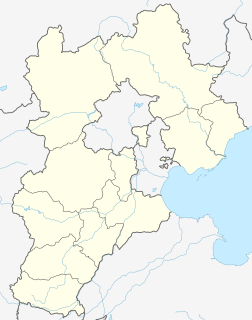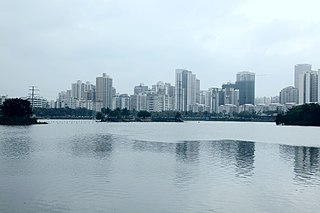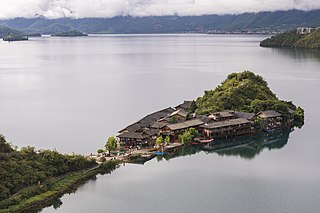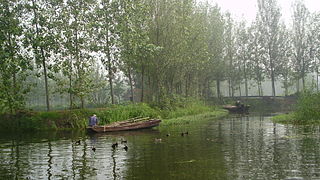 W
WThe Five Lakes or Wu Hu, is a Chinese historical and geographical concept that has been used to describe various lakes in China.
 W
WThis is a list of lakes of China.
 W
WEbi Lake is a rift lake in Xinjiang Uyghur Autonomous Region in Northwestern China, near the border of Kazakhstan. Lying at the southeast end of the Dzungarian Gate, Ebi Lake is the center of the catchment of the southwestern part of the Dzungarian Basin. The lake previously covered over 1000 km2 with an average depth of less than 2 meters. In August 2007, the Chinese government designated the adjoining Aibi Lake wetland as a National Nature Reserve.
 W
WAydingkol, Aydingkul (Mongol) or Ayding is a lake in the Turpan Depression, Xinjiang Uyghur Autonomous Region, PR China. At 154 m below sea level, it is the lowest point in China. This lake is now totally dried, and very muddy and salty.
 W
WBaiyang Lake, also known as Lake Baiyangdian, is located in the Xiong'an New Area of Baoding, a prefecture-level city in Hebei Province, China. It is the largest freshwater lake in northern China. It is referred to as the Kidney of North China.
 W
WBosten Lake is a freshwater lake on the northeastern rim of the Tarim Basin, about 20 km (12 mi) east of Yanqi and 57 km (35 mi) northeast of Korla, Xinjiang, China in the Bayin'gholin Mongol Autonomous Prefecture. Covering an area of about 1,000 km2 (390 sq mi), it is the largest lake in Xinjiang and one of the largest inland freshwater lakes in China. Bosten lake receives water inflow from a catchment area of 56,000 km2 (22,000 sq mi).
 W
WCaohai Lake is a natural water-body situated in Northwest Guizhou Province of Southwest China. The lake is situated on Weining Mountain, in the outskirts of Weining County. Caohai Village lies directly at the edge of the wetland.
 W
WChagan Lake is a lake in Jilin, China. The name "Chagan" is from Mongolian, meaning white / pure lake. It is often referred to as the Sacred Lake or Holy Water Lake by local people. The lake is known for its traditional winter fishing, featuring a technique which dates back to prehistoric times.
 W
WChaka Salt Lake is a salt lake in Ulan County, Haixi Prefecture, Qinghai, China. The oval-shaped lake is located near the eastern end of Qaidam Basin, 298 kilometres (185 mi) to the west of the provincial capital Xining. The name "Chaka" means "salt lake" in Tibetan.
 W
WChangfeng Park is a landscaped park in the west of Shanghai, China. The size of the park is 364,000 square meters. It features an artificial lake, Yinchu Lake, and an artificial hill, Tiebi Hill. There are various facilities including a Sea Life aquarium and boating on the lake.
 W
WYueyaquan is a crescent-shaped lake in an oasis, 6 km south of the city of Dunhuang in Gansu Province, China.
 W
WDabiele Lake, also known by other names, is an ephemeral lake in the southwestern Qarhan Playa north of Golmud in the Haixi Prefecture of Qinghai Province in northwestern China. It is fed by the Tuolahai and Qingshui Rivers from the Kunlun Mountains to the south. Like the other lakes of the surrounding Qaidam Basin, it is extremely saline; like the other lakes in the Bieletan subbasin, it is rich in lithium.
 W
WDabusun or Dabuxun Lake, alternately known as Dabasun Nor, is a lake beside the town Qarhan, just north of Golmud in the Haixi Prefecture of Qinghai Province in northwestern China. Fed by the main course of the Golmud River, it is the largest present-day lake in the Qarhan Playa. Like the other lakes of the surrounding Qaidam Basin, it is extremely saline, with 307–338 grams of salt per liter of water (2.5 lb/gallon).
 W
WLake Dai, also known by its Chinese name Daihai, is a lake in Liangcheng County, Ulanqab Prefecture, Inner Mongolia, China.
 W
WDaming Lake (Chinese: 大明湖; pinyin: Dà Míng Hú; Wade–Giles: Ta4 Ming2 Hu2; lit.: 'Lake of the Great Splendour') is the largest lake in the city of Jinan, Shandong, China and one of city's main natural and cultural landmarks. Located to the north of the historical city center, the lake is fed by the artesian karst springs of the area and hence retains a fairly constant water level through the entire year.
 W
WDianshan Lake is a freshwater lake west of Zhujiajiao, Qingpu District, in Shanghai, China. Measuring 62 square kilometers (23.9 sq mi), it is the largest freshwater lake in Shanghai and the upstream of the Huangpu River.
 W
WDiexi Lake is a lake in Diexi, Mao County, Sichuan, China.
 W
WDongling Lake is a lake in the Qarhan Playa north of Golmud in the Haixi Prefecture of Qinghai Province in northwestern China. Like the other lakes of the surrounding Qaidam Basin, it is extremely saline.
 W
WThe Dongping Lake(Chinese: 东平湖; pinyin: DōngpíngHú) is a freshwater lake in Shandong Province of China. It is situated in Dongping County in the west of Shandong Province, south of the lower reaches of Yellow River. The lake has a total area of about 148 square kilometers. The average depth is 1.59 m, the water storage capacity is about 2.35×108m3.
 W
WDongqian Lake is a large freshwater lake in Yinzhou District, Ningbo in the Zhejiang, China. It has a surface area of 20 square kilometres (7.7 sq mi).
 W
WEast Lake Triangle Pool, commonly known as East Lake, is a set of two small lakes in the East Lake area of Haikou, Hainan, China. It is located at the south-west corner of the Bo'ai Road area and at the north side of People's Park.
 W
WGyaring Lake or Zhaling Lake is a large freshwater lake in the Yellow River catchment in China, it is in the southeast of Qinghai Province, on the border between Yushu Tibetan Autonomous Prefecture and Golog Tibetan Autonomous Prefecture. The name of lake means "Long Gray Lake" in Tibetan language. Gyaring Lake is 526 km², with a drainage area of 8161 km², an elevation of 4292 m, a length of 35 km and a mean width of 15 km.
 W
WHeaven Lake is a crater lake on the border between China and North Korea. It lies within a caldera atop the volcanic Paektu Mountain, a part of the Baekdudaegan mountain range and the Changbai mountain range. It is located partly in Ryanggang Province, North Korea, at 42.006°N 128.057°E, and partly in Jilin Province, northeastern China. Heaven Lake has been recognized as the highest volcanic lake in the world by Guinness Book of Records.
 W
WHongcheng Lake is a lake in Haikou, Hainan, China. It was renovated around 2017 to 2018. It has three islands. Two small, and one, at the west side, is larger with short bridge access and an old, dilapidated building on it.
 W
WHongshan Reservoir is a small artificial lake in Anshun City, Guizhou province, China, used for water retention on a branch of the Dabang River. Its dam was built in 1958, and it reached capacity in 1959. It was given a makeover in 2017 and is now surrounded with park landscaping where possible, and has amenities such as art installations, boardwalks, recreational paths, pedestrian bridges and picnic areas. In 2020 it was the site of the Anshun bus crash, when a bus veered off the dam road, down the viewing steps, and into the water.
 W
WHouhai is a lake and its surrounding neighborhood in Xicheng District of central Beijing, China. Houhai is the largest of the three lakes, along with Qianhai 'Front Lake' and Xihai 'Western Lake', that comprise Shichahai, the collective name for the three northernmost lakes in central Beijing. Since the early 2000s, the hutong neighborhood around Houhai has become known for its nightlife as many residences along the lake shore have been converted into restaurants, bars, and cafes. The area is especially popular with foreign tourists visiting Beijing and is also often visited by the expatriate community and the younger generations of locals.
 W
WHuajiachi is a lake in Hangzhou, Zhejiang.
 W
WLake Huangqi, also known by its Chinese name as the Huangqi Hai, is a lake in Chahar Right Front Banner, Ulanqab Prefecture, Inner Mongolia, China.
 W
WThe Hundred Flower Pond is a small artificial lake in the historical center of the City of Jinan, Shandong Province, China. It is located east of the northern end of Qushuiting Street and south of Daming Lake Road.
 W
WJingpo Lake or Lake Jingpo is a lake located in the upper reaches of the Mudan River among the Wanda Mountains in Ningan County, Heilongjiang, in the People's Republic of China. Earlier names for the lake include Meituohu Lake (湄沱湖), Huhanhai Lake (忽汗海), and Bilten Lake.
 W
WJunshan Lake (Chinese: 军山湖; pinyin: Jūnshān Hú)also known as "Sun Moon Lake" (Chinese: 日月湖; pinyin: Rìyuè Hú)during ancient times, is a freshwater lake in China. It is located in Jinxian County of Jiangxi Province, situated to the south of Poyang Lake. The drainage basin has an area of 615 km2, with an elevation of 18 m, a length of 25 km and a greatest breadth from east to west of 18.2 km (the average breadth is only 7.7 km). The lake has a surface area of 192.5 km2, and volume is about 7.66×108m3. The maximum depth of the Junshan Lake is 6.4 m, though the average is 4 m. The lake is rich in fish and crab.
 W
WLake Khanka or Lake Xingkai, is a freshwater lake on the border between Primorsky Krai, Russia and Heilongjiang province, Northeast China.
 W
WKunming Lake is the central lake on the grounds of the Summer Palace in Beijing, China. Together with the Longevity Hill, Kunming Lake forms the key landscape features of the Summer Palace gardens.
 W
WLugu Lake is located in the northwest of the Yunnan plateau, with the middle of the lake forming the border between the Ninglang County of Yunnan Province and the Yanyuan County of Sichuan Province. The formation of the lake is thought to have occurred in a geological fault belonging to the geological age of the Late Cenozoic. It is an alpine lake at an elevation of 2,685 metres (8,809 ft) and is the highest lake in the Yunnan Province. The lake is surrounded by mountains and has five islands, four peninsulas, fourteen bays and seventeen beaches.
 W
WNansi Lake, or Weishan Lake, administrated by Weishan County and located in Shandong Province in China, is the largest freshwater lake in the north of the country. It consists of four connected lakes: Weishan, Zhaoyang, Nanyang, Dushan. It is 120 km long and 1266 square km in area.
 W
WNgoring Lake or Ngoreng Lake or Eling Lake is a large freshwater lake in the Yellow River catchment, it is in the southeast of Qinghai Province.The name of lake means "Long Blue Lake" in Tibetan language. Ngoring Lake is 610.7 km 2, with a drainage area of 18,188 km 2, an elevation of 4268 m, length 32.3 km and mean width 18.9 km.
 W
WNorth or Bei Hulsan Lake, also known by other names, is a lake northeast of Golmud in Dulan County, Haixi Prefecture, Qinghai Province, China. A part of the Qarhan Playa, it is filled from the east by the Qaidam River. Like the other lakes of the surrounding Qaidam Basin, it is extremely saline.
 W
WPoyang Lake, located in Jiangxi Province, is the largest freshwater lake in China.
 W
WQiandao Lake, a human-made, freshwater lake located in Chun'an County, Zhejiang Province, China, was formed after the completion of the Xin'an River hydroelectric station in 1959.
 W
WQinghai Lake or Ch'inghai Lake, also known by other names, is the largest lake in China. Located in an endorheic basin in Qinghai Province, to which it gave its name, Qinghai Lake is classified as an alkaline salt lake. The lake has fluctuated in size, shrinking over much of the 20th century but increasing since 2004. It had a surface area of 4,317 km2 (1,667 sq mi), an average depth of 21 m (69 ft), and a maximum depth of 25.5 m (84 ft) in 2008.
 W
WQiong Lake, sometimes tautologically referred to as Qionghai Lake, is a freshwater lake in Liangshan Prefecture, Sichuan, and is the second largest lake in Sichuan. The lake is located in a depression on the east side of the Anning River valley, in a mountainous region of the province between the Hengduan Mountains and the Yungui Plateau. Xichang, the capital of Liangshan Prefecture, is located on the northwest shores of the lake and the entire of the lake is within Xichang County.
 W
WRuyi Lake is a small artificial lake located in the city of Zhengzhou, Henan, China.
 W
WSayram Lake is located in the Bortala Prefecture near the Tian Shan Mountains, Xinjiang, China.
 W
WSouth or Nan Hulsan Lake, also known by other names, is a lake northeast of Golmud in Dulan County, Haixi Prefecture, Qinghai Province, China. A part of the Qarhan Playa, it lies east of Tuanjie Lake and south of North Hulsan Lake. Like the other lakes of the surrounding Qaidam Basin, it is extremely saline.
 W
WSouth Lake is a lake in the South of Jiaxing, Zhejiang, China, and covers an area of 0.54 km². It is also known as "Mandarin Duck Lake" due to its shape.
 W
WSouth, Little, or New Suli or Senie Lake is a small ephemeral lake in Golmud County, Haixi Prefecture, Qinghai Province, China. It lies in the southwest corner of the Qarhan Playa in the southeast Qaidam Basin. It is part of Qarhan's Bieletan subbasin, located south of Suli Lake and west of Dabiele Lake. It is principally fed from the southwest by the Zaohuo or Little Zaohuo River (小灶火河, Xiǎozàohuǒ Hé) and consists of a 1.5 km2 (0.58 sq mi) basin which gradually evaporates into three smaller ponds. As part of the Bieletan subbasin, it is rich in lithium chloride.
 W
WSuli or Senie Lake is a lake in the western Qarhan Playa north of Golmud in the Haixi Prefecture of Qinghai Province in northwestern China. It is fed from the west by the Urt Moron River. Like the other lakes of the surrounding Qaidam Basin, it is extremely saline; like the other lakes of the surrounding Bieletan subbasin, it is rich in lithium. Its underlying salt has also trapped one of China's largest onshore natural gas fields.
 W
WTaihu, also known as Lake Tai or Lake Taihu, is a lake in the Yangtze Delta and one of the largest freshwater lakes in China. The lake lies in Jiangsu province and significant part of its southern shore forms its border with Zhejiang. With an area of 2,250 square kilometers (869 sq mi) and an average depth of 2 meters (6.6 ft), it is the third-largest freshwater lake entirely in China, after Poyang and Dongting. The lake holds about 90 islands, ranging in size from a few square meters to several square kilometers.
 W
WTaiye Lake or Taiye Pond was an artificial lake in imperial City, Beijing during the Jin, Yuan, Ming, and Qing dynasties of China. The beauty and utility of the lake was responsible for the siting of Kublai Khan's palace and the position of modern Beijing. It continues to exist but it is now known separately as the "North", "Central", and "South Sea"s, the three interconnected lakes just west of the Forbidden City in downtown Beijing. The northern lake makes up the public Beihai Park while the southern two are grouped together as Zhongnanhai, the headquarters for the Communist leadership of the People's Republic of China.
 W
WTangjiashan Lake is a landslide dam-created lake on the Jian River, which was formed by the 2008 Sichuan earthquake. Its name comes from the nearby mountain Tangjiashan. On May 24, 2008 the water level rose by 2 metres in a single day, reaching a depth of 23 metres (75 ft), just 29 metres (95 ft) below the barrier level. On June 9 2008, more than 250,000 people have been evacuated from Mianyang in anticipation of the Tangjiashan Lake dam bursting.
 W
WTuanjie Lake is a lake in the southeastern Qarhan Playa north of Golmud in the Haixi Prefecture of Qinghai Province in northwestern China. It is fed from the south by the Shougong River. Like the other lakes of the surrounding Qaidam Basin, it is extremely saline.
 W
WUlungur Lake is located in Fuhai County, Xinjiang, China. With an area of 1,035 square kilometers, the lake is one of China's ten largest freshwater lakes. Its main tributary is the Ulungur River. It is an endorheic lake, though the Irtysh River flows towards the Arctic Ocean less than 4 km away to the northeast.
 W
WWest Dabusun or Dabuxun Lake is an ephemeral lake northwest of Golmud in the Haixi Prefecture of Qinghai Province in northwestern China. Comprising a basin in the Qarhan Playa, it fills when meltwater floods the Golmud River, causing it to spill into subsidiary channels west of the main course to Dabusun Lake. Like the other lakes of the surrounding Qaidam Basin, it is extremely saline.
 W
WWest Lake is a freshwater lake in Hangzhou, China. It is divided into five sections by three causeways. There are numerous temples, pagodas, gardens, and natural/artificial islands within the lake. Gushan (孤山) is the largest natural island and three artificial islands: Xiaoyingzhou (小瀛洲), Huixin Pavilion (湖心亭), and Ruan Gongdun (阮公墩) stand at the middle of the lake. Leifeng Pagoda (雷峰塔) and Baochu Pagoda (保俶塔) are separated by the lake. Mirroring each other, the basic pattern of "one mountain, two towers, three islands, three banks, and five lakes" is formed.
 W
WXiaobiele Lake or Xiaobieletan is an ephemeral lake in the southwestern Qarhan Playa north of Golmud in the Haixi Prefecture of Qinghai Province in northwestern China. Like the other lakes of the surrounding Qaidam Basin, it is extremely saline; like the other lakes of the surrounding Bieletan subbasin, it is rich in lithium.
 W
WXiechi Lake, also called Yuncheng yanchi is the largest natural lake in Shanxi in Northern China. It is a saline lake used for production of salt.
 W
WXiezuo Lake is a lake in the northeastern Qarhan Playa north of Golmud in Dulan County, Haixi Prefecture, Qinghai Province, China. Like the other lakes of the surrounding Qaidam Basin, it is extremely saline.
 W
WYihun Lhatso, also transliterated from Tibetan as Yilung Latsho, is a glacial lake in the Tibetan area of western Sichuan Province, China.
 W
WChangfeng Park is a landscaped park in the west of Shanghai, China. The size of the park is 364,000 square meters. It features an artificial lake, Yinchu Lake, and an artificial hill, Tiebi Hill. There are various facilities including a Sea Life aquarium and boating on the lake.
 W
WZhuye Lake is the terminal lake of the Shiyang River, which is located in the east of the Hexi Corridor in Gansu Province, China. Zhuye Lake is located in the marginal area of the Asian monsoon and is affected by both the Asian monsoon system and the Westerly jet. By understanding the Holocene record in Zhuye Lake, the interaction of different climate systems during the Holocene can be studied. At the same time, the Asian monsoon system is climatically dynamic; changes in its sphere of influence can result in severe drought or flood over large, densely populated, regions. In addition, Zhuye Lake and the surrounding area in arid NW China are in ecological imbalance – a consequence of human impacts and climate. Understanding the environmental history here can assist climatological forecasting of the Asian monsoon system and ecosystem reconstruction.